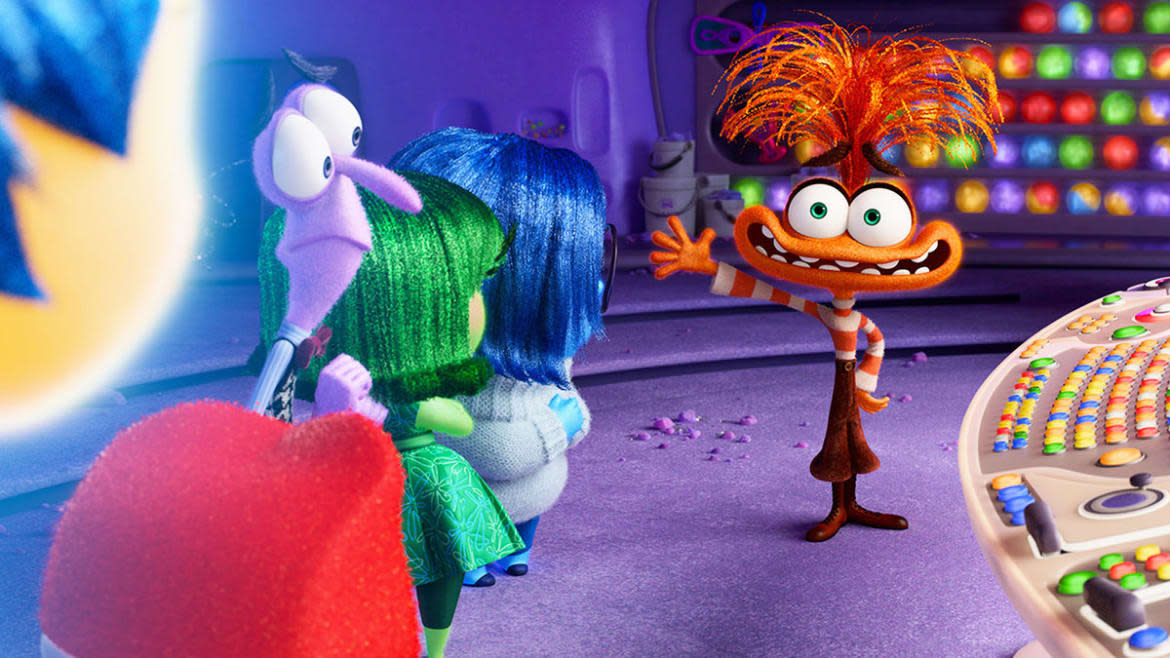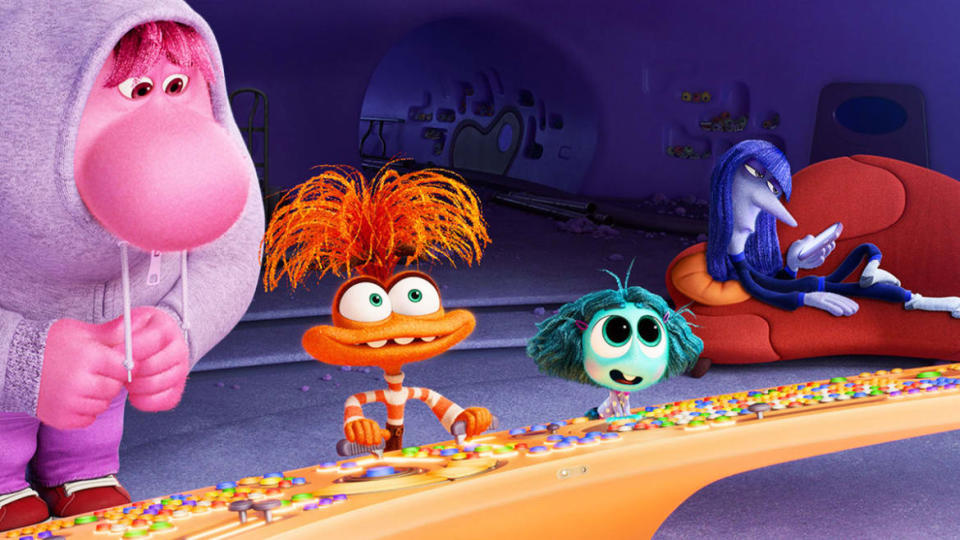The ‘Inside Out 2’ Anxiety Attack Really F*cked Me Up

(Warning: Spoilers for Inside Out 2 ahead.)
While Inside Out included five core emotions: Joy, Sadness, Fear, Anger, and Disgust, Inside Out 2 added a new roster to the team, including one bossy emotion in particular: Anxiety. The climax of the movie features a full-blown anxiety attack, which is experienced by Riley—the 13 year old whom these emotions live inside—the emotions themselves, and me, while sitting in a full movie theater on a Friday night.
I have some kind of somewhat undefined neurodiversity soup up in my head which includes an element of anxiety. At one point, I was diagnosed with a panic disorder, which I have bested with coping skills and meds, but I experience “generalized anxiety” on the reg.
I also have two children. When the first Inside Out came out in 2015, I had one infant. I saw the movie in theaters as one of my first outings without the baby in tow. As the Michael Giacchino theme started up, baby Riley was born, Joy appeared, and I burst into postpartum tears. Pixar is notorious for making people cry, especially with its music, but Inside Out has always affected me. As my bundle of Joy (chaos) grew, they were much like the character, Riley: silly, sometimes sad, often angry. Now my kid is staring down the barrel of puberty, just like Riley. When the Giacchino theme started again at the beginning of the sequel, I welled up but recovered quickly.
‘Inside Out 2’ Is Brilliant: The Win Pixar Desperately Needs
It wasn’t until its climactic anxiety attack that I really started to lose it. I’d been enjoying the movie up until then, laughing along with the other parents at the jokes aimed at us (Riley’s dad asks her mom, “What do you want to do this weekend while Riley’s gone?” and raises his eyebrows suggestively. Riley’s mom says, “I guess we could clean out the garage?” and a decidedly adult female chuckle reverberated throughout the theater).
However, during the big hockey game toward the end, Riley gets put in the penalty box and begins to hyperventilate, as, inside her head, Anxiety forces all the other emotions out of the command center and begins to swirl around the board, stirring up a storm. Earlier in the movie, Anxiety ripped out the beautiful, delicate “true self” Riley had grown over her lifetime, and had thrown it in “the back of her mind.” Joy tries to retrieve it, but because of the chaos inside the command center, including a new version of Riley’s “true self” built on the idea that she’s “not good enough,” Joy is faltering.
I was the emoji with the two streams of tears running down her face. The stranger sitting next to me was his child companion’s uncle, which I got from context clues (“Uncle Josh, I have to go POTTY!”). I tried not to sob audibly both because I didn’t want to freak out this random dude (I’ve more than once been told my experience of parenthood is good birth control—see screenshot of my Facebook memory from today), and because my children were now staring at me. My son crawled into my lap and kissed my wet face. “Are you okay?” he asked. I felt guilty for worrying them. I tried, like Joy does, to stuff the bad feelings back into the back of my mind, but like in the movie, that was only making things worse. I was having an anxiety attack along with Riley.

Embarrassment (Paul Walter Hauser), Anxiety (Maya Hawke), Envy (Ayo Edebiri) and Ennui (Adèle Exarchopoulos) are ready to take a turn at the console.
Then Joy uttered the line that broke me. “Maybe that’s what happens as you grow up. You feel less joy.” Other reviews of the movie have said they could hear grownups weeping around them at that line, but I was too busy with the storm inside my own mind. It was nearly unbearable, but where could I go?
Joy and friends make it to the command center and Joy fights her way into the swirl of Anxiety. Anxiety doesn’t look pleased with herself, holding onto the board with a vice grip, shaking. Joy tries to pry Anxiety away, and Anxiety says, “I was just trying to protect Riley!”
Vanquishing my panic disorder included accepting that my anxiety was trying to help me but that there was nothing to be afraid of. I used to get panic attacks every time I’d walk uphill in my very hilly neighborhood. My brain misinterpreted my raised heart rate as a sign that a monster was chasing me, and it sent me into panic mode. I overcame it by taking deep breaths, accepting love from others (like my dog and friends), and focusing on what was real: the smell of fresh air, the feel of the leash in my hands. Riley does the same. She feels her hands on her legs, sees the sun coming through the windows, and takes a deep breath. She steps out of the penalty box and looks into the sun.
“Joy,” Sadness says, “Riley wants you.”
Shout Out to Sadness: The Greatest Character of Our Time
Resilient child Riley desperately wanted to be happy. Anxiety isn’t a choice for her; she was invaded. But, with the help of finding Joy again, she was able to move through it, repair the hurt she caused in the process, and be happy again, even during puberty! I felt the tightness ease from my heart, as Riley and I enjoyed the moment.
Then, as the movie winded down, that theme started once more, and my son, for all to hear, yelled, “There’s that music again!” He shot a glance at me, and I laughed, letting the last tears fall before the lights came up.
Pixar recently released a poorly received edict about how it’s planning to produce universal stories versus the ones that are “too specific,” with Inside Out being a good example of the former and Turning Red and Luca being negative examples of the latter. However, it's the universality within each of these Pixar movies that really gets to people’s emotional core. I don't have the cultural background of the characters inTurning Red, but I did have a mom who struggled to accept me as I was, which contributed to my sense of self; like anxious Riley, it was often shouting at me, “I’m not good enough.” I’m not a fish (duh), but I did watch Finding Nemo with my mom right before leaving for college, and the universal theme of learning to trust your child out in the world hit us both.
Inside Out 2, from a cultural perspective, was specifically “for me” as a white kid raised in the Bay Area who is now the parent to an anxious blonde child or two. But just like those other films, its universal themes—about being true to yourself, growing up and feeling more complex emotions, and learning to use your internal resources to navigate the world and find joy—can be applied to all of us. While I cried my eyes out during the movie and in writing about it afterward, I’m glad to have experienced the emotional catharsis and I’m glad my kids got to see me moving through my emotions. TBD on if Trauma is going to be a character in Inside Out 3. If so, we’re done for.
Get the Daily Beast's biggest scoops and scandals delivered right to your inbox. Sign up now.
Stay informed and gain unlimited access to the Daily Beast's unmatched reporting. Subscribe now.

 Yahoo News
Yahoo News 